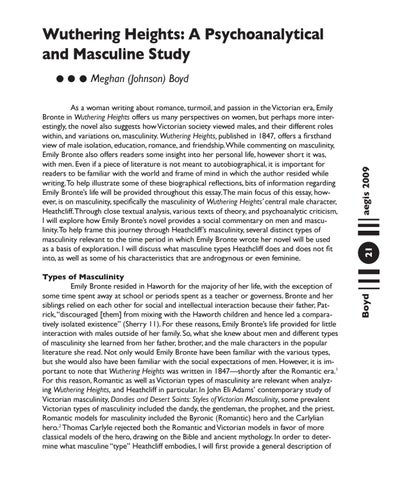Wuthering Heights: A Psychoanalytical and Masculine Study
Types of Masculinity Emily Bronte resided in Haworth for the majority of her life, with the exception of some time spent away at school or periods spent as a teacher or governess. Bronte and her siblings relied on each other for social and intellectual interaction because their father, Patrick, “discouraged [them] from mixing with the Haworth children and hence led a comparatively isolated existence” (Sherry 11). For these reasons, Emily Bronte’s life provided for little interaction with males outside of her family. So, what she knew about men and different types of masculinity she learned from her father, brother, and the male characters in the popular literature she read. Not only would Emily Bronte have been familiar with the various types, but she would also have been familiar with the social expectations of men. However, it is important to note that Wuthering Heights was written in 1847—shortly after the Romantic era.1 For this reason, Romantic as well as Victorian types of masculinity are relevant when analyzing Wuthering Heights, and Heathcliff in particular. In John Eli Adams’ contemporary study of Victorian masculinity, Dandies and Desert Saints: Styles of Victorian Masculinity, some prevalent Victorian types of masculinity included the dandy, the gentleman, the prophet, and the priest. Romantic models for masculinity included the Byronic (Romantic) hero and the Carlylian hero.2 Thomas Carlyle rejected both the Romantic and Victorian models in favor of more classical models of the hero, drawing on the Bible and ancient mythology. In order to determine what masculine “type” Heathcliff embodies, I will first provide a general description of
21 Boyd
As a woman writing about romance, turmoil, and passion in the Victorian era, Emily Bronte in Wuthering Heights offers us many perspectives on women, but perhaps more interestingly, the novel also suggests how Victorian society viewed males, and their different roles within, and variations on, masculinity. Wuthering Heights, published in 1847, offers a firsthand view of male isolation, education, romance, and friendship. While commenting on masculinity, Emily Bronte also offers readers some insight into her personal life, however short it was, with men. Even if a piece of literature is not meant to autobiographical, it is important for readers to be familiar with the world and frame of mind in which the author resided while writing. To help illustrate some of these biographical reflections, bits of information regarding Emily Bronte’s life will be provided throughout this essay. The main focus of this essay, however, is on masculinity, specifically the masculinity of Wuthering Heights’ central male character, Heathcliff. Through close textual analysis, various texts of theory, and psychoanalytic criticism, I will explore how Emily Bronte’s novel provides a social commentary on men and masculinity. To help frame this journey through Heathcliff’s masculinity, several distinct types of masculinity relevant to the time period in which Emily Bronte wrote her novel will be used as a basis of exploration. I will discuss what masculine types Heathcliff does and does not fit into, as well as some of his characteristics that are androgynous or even feminine.
aegis 2009
Meghan (Johnson) Boyd

